Analyzing Financial Globalization: Impact on Economies and Markets
VerifiedAdded on 2022/06/07
|12
|2635
|31
Report
AI Summary
This report provides a comprehensive analysis of financial globalization, exploring its impact on various countries and their economic behavior. It begins with an introduction to financial globalization and its relevance to emerging markets, followed by a literature review covering related theories like neoclassical growth theory, modern portfolio theory and market imperfection theory. The report then delves into practical applications, including case studies of the Caucasus and Central Asia, global capital flows, and China's capital outflow, along with the success story of Singapore. The report also includes the author's perspective on financial globalization and concludes by summarizing the pros and cons of financial globalization, emphasizing the need for countries to manage cross-border transactions effectively to achieve long-term stable growth. The findings suggest that financial globalization presents both opportunities and challenges, with its impact varying depending on a country's economic policies and regulatory framework. This report is contributed by a student on Desklib.
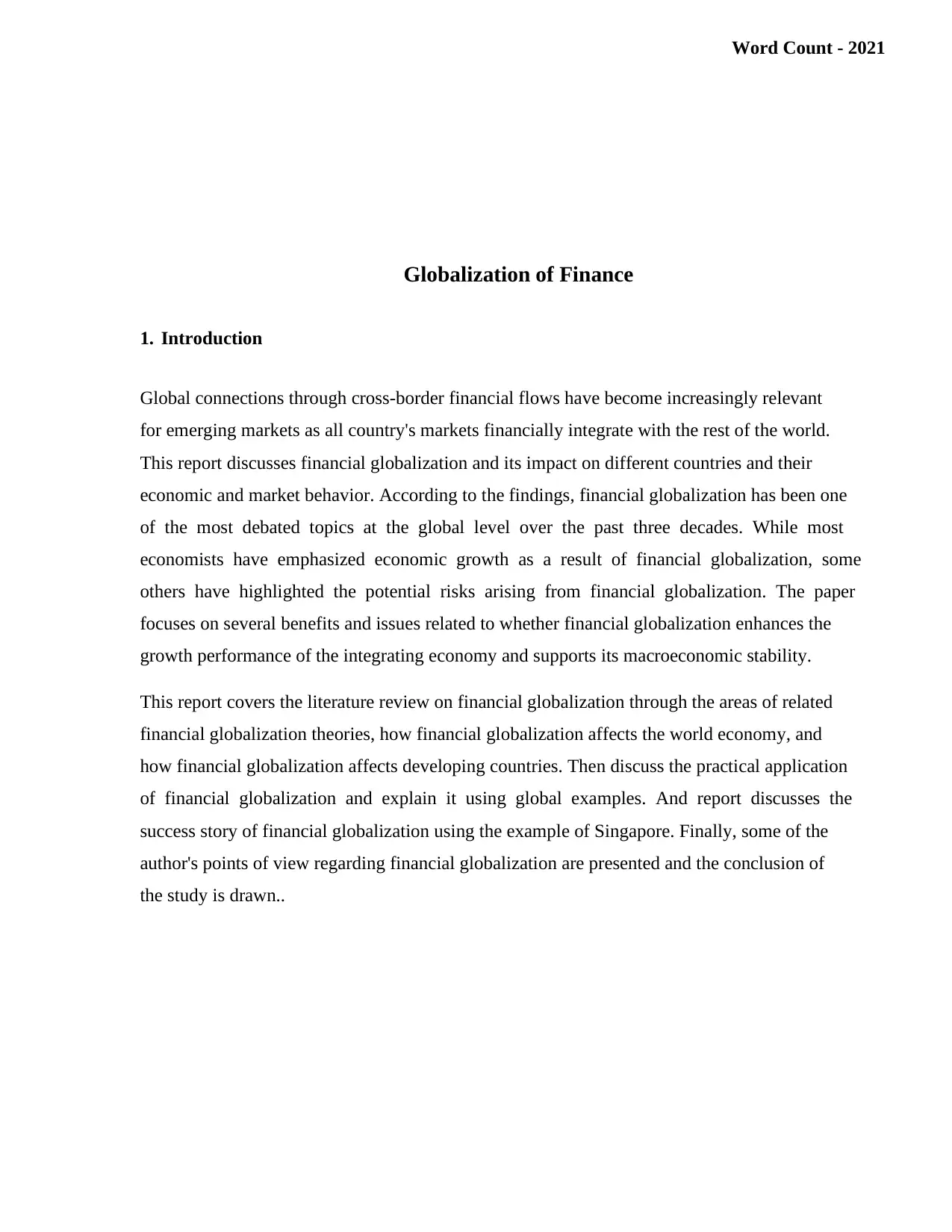
Globalization of Finance
1. Introduction
Global connections through cross-border financial flows have become increasingly relevant
for emerging markets as all country's markets financially integrate with the rest of the world.
This report discusses financial globalization and its impact on different countries and their
economic and market behavior. According to the findings, financial globalization has been one
of the most debated topics at the global level over the past three decades. While most
economists have emphasized economic growth as a result of financial globalization, some
others have highlighted the potential risks arising from financial globalization. The paper
focuses on several benefits and issues related to whether financial globalization enhances the
growth performance of the integrating economy and supports its macroeconomic stability.
This report covers the literature review on financial globalization through the areas of related
financial globalization theories, how financial globalization affects the world economy, and
how financial globalization affects developing countries. Then discuss the practical application
of financial globalization and explain it using global examples. And report discusses the
success story of financial globalization using the example of Singapore. Finally, some of the
author's points of view regarding financial globalization are presented and the conclusion of
the study is drawn..
Word Count - 2021
1. Introduction
Global connections through cross-border financial flows have become increasingly relevant
for emerging markets as all country's markets financially integrate with the rest of the world.
This report discusses financial globalization and its impact on different countries and their
economic and market behavior. According to the findings, financial globalization has been one
of the most debated topics at the global level over the past three decades. While most
economists have emphasized economic growth as a result of financial globalization, some
others have highlighted the potential risks arising from financial globalization. The paper
focuses on several benefits and issues related to whether financial globalization enhances the
growth performance of the integrating economy and supports its macroeconomic stability.
This report covers the literature review on financial globalization through the areas of related
financial globalization theories, how financial globalization affects the world economy, and
how financial globalization affects developing countries. Then discuss the practical application
of financial globalization and explain it using global examples. And report discusses the
success story of financial globalization using the example of Singapore. Finally, some of the
author's points of view regarding financial globalization are presented and the conclusion of
the study is drawn..
Word Count - 2021
Paraphrase This Document
Need a fresh take? Get an instant paraphrase of this document with our AI Paraphraser
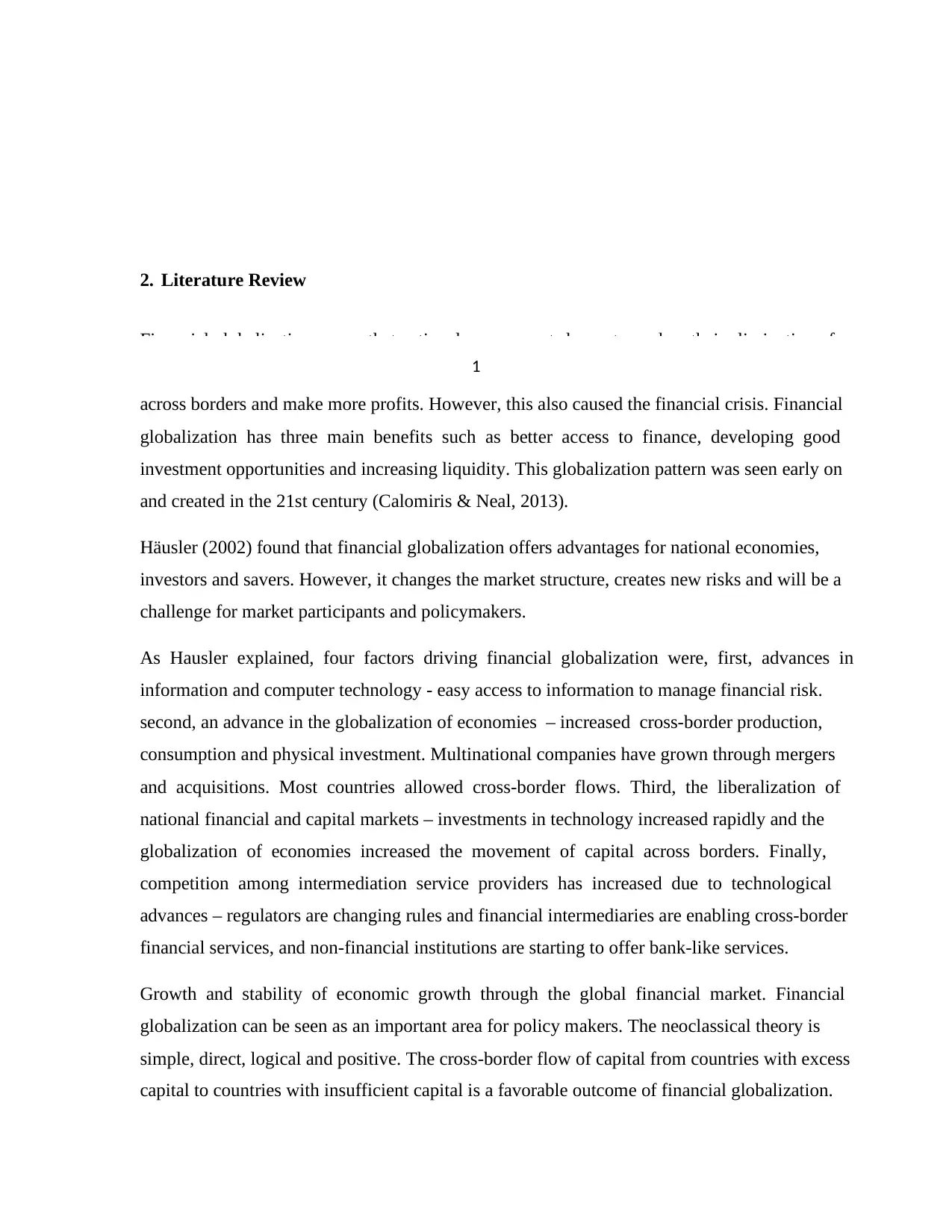
2. Literature Review
Financial globalization means that national governments have stepped up their elimination of
state capital control. This deletion created more and more opportunities for companies to invest
across borders and make more profits. However, this also caused the financial crisis. Financial
globalization has three main benefits such as better access to finance, developing good
investment opportunities and increasing liquidity. This globalization pattern was seen early on
and created in the 21st century (Calomiris & Neal, 2013).
Häusler (2002) found that financial globalization offers advantages for national economies,
investors and savers. However, it changes the market structure, creates new risks and will be a
challenge for market participants and policymakers.
As Hausler explained, four factors driving financial globalization were, first, advances in
information and computer technology - easy access to information to manage financial risk.
second, an advance in the globalization of economies – increased cross-border production,
consumption and physical investment. Multinational companies have grown through mergers
and acquisitions. Most countries allowed cross-border flows. Third, the liberalization of
national financial and capital markets – investments in technology increased rapidly and the
globalization of economies increased the movement of capital across borders. Finally,
competition among intermediation service providers has increased due to technological
advances – regulators are changing rules and financial intermediaries are enabling cross-border
financial services, and non-financial institutions are starting to offer bank-like services.
Growth and stability of economic growth through the global financial market. Financial
globalization can be seen as an important area for policy makers. The neoclassical theory is
simple, direct, logical and positive. The cross-border flow of capital from countries with excess
capital to countries with insufficient capital is a favorable outcome of financial globalization.
1
Financial globalization means that national governments have stepped up their elimination of
state capital control. This deletion created more and more opportunities for companies to invest
across borders and make more profits. However, this also caused the financial crisis. Financial
globalization has three main benefits such as better access to finance, developing good
investment opportunities and increasing liquidity. This globalization pattern was seen early on
and created in the 21st century (Calomiris & Neal, 2013).
Häusler (2002) found that financial globalization offers advantages for national economies,
investors and savers. However, it changes the market structure, creates new risks and will be a
challenge for market participants and policymakers.
As Hausler explained, four factors driving financial globalization were, first, advances in
information and computer technology - easy access to information to manage financial risk.
second, an advance in the globalization of economies – increased cross-border production,
consumption and physical investment. Multinational companies have grown through mergers
and acquisitions. Most countries allowed cross-border flows. Third, the liberalization of
national financial and capital markets – investments in technology increased rapidly and the
globalization of economies increased the movement of capital across borders. Finally,
competition among intermediation service providers has increased due to technological
advances – regulators are changing rules and financial intermediaries are enabling cross-border
financial services, and non-financial institutions are starting to offer bank-like services.
Growth and stability of economic growth through the global financial market. Financial
globalization can be seen as an important area for policy makers. The neoclassical theory is
simple, direct, logical and positive. The cross-border flow of capital from countries with excess
capital to countries with insufficient capital is a favorable outcome of financial globalization.
1
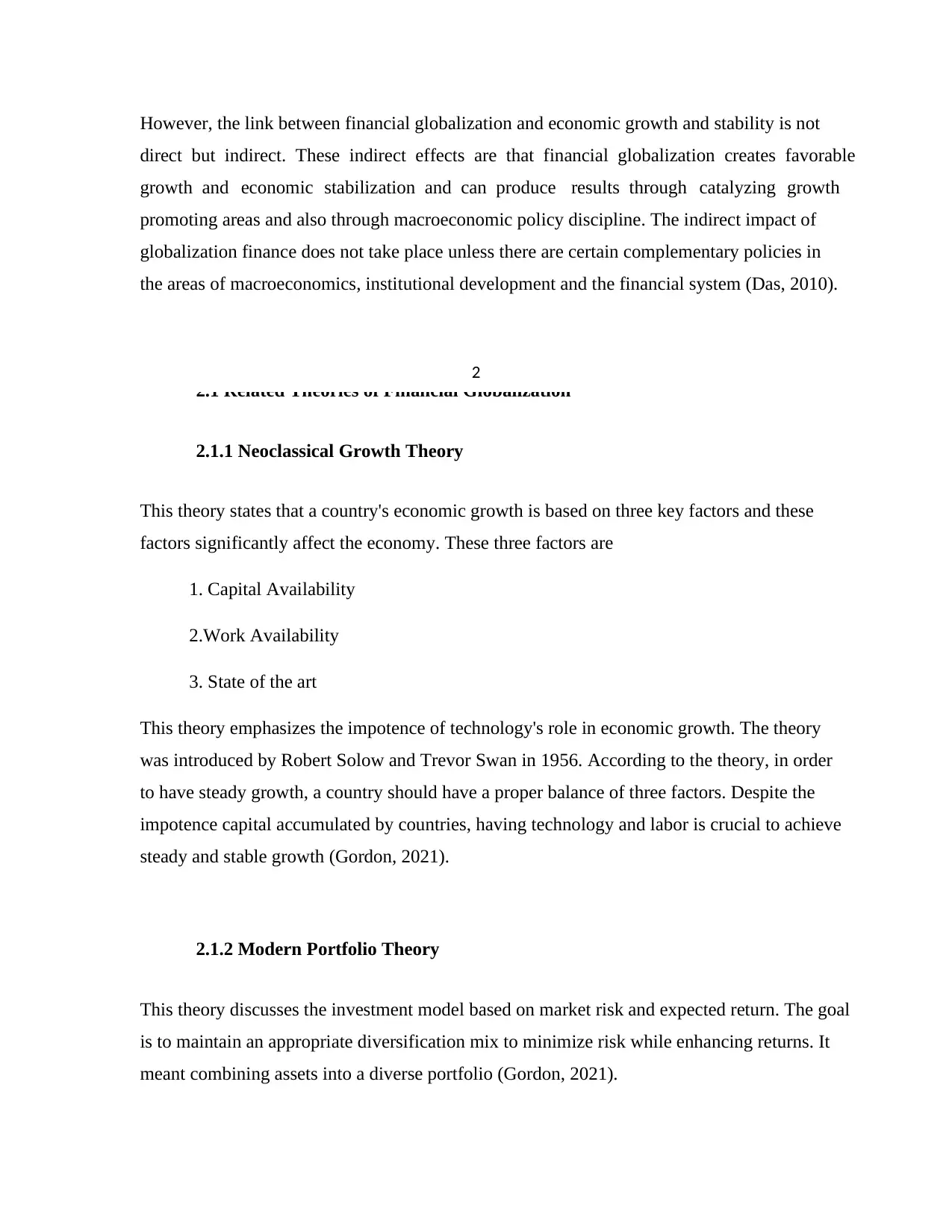
However, the link between financial globalization and economic growth and stability is not
direct but indirect. These indirect effects are that financial globalization creates favorable
growth and economic stabilization and can produce results through catalyzing growth
promoting areas and also through macroeconomic policy discipline. The indirect impact of
globalization finance does not take place unless there are certain complementary policies in
the areas of macroeconomics, institutional development and the financial system (Das, 2010).
2.1 Related Theories of Financial Globalization
2.1.1 Neoclassical Growth Theory
This theory states that a country's economic growth is based on three key factors and these
factors significantly affect the economy. These three factors are
1. Capital Availability
2.Work Availability
3. State of the art
This theory emphasizes the impotence of technology's role in economic growth. The theory
was introduced by Robert Solow and Trevor Swan in 1956. According to the theory, in order
to have steady growth, a country should have a proper balance of three factors. Despite the
impotence capital accumulated by countries, having technology and labor is crucial to achieve
steady and stable growth (Gordon, 2021).
2.1.2 Modern Portfolio Theory
This theory discusses the investment model based on market risk and expected return. The goal
is to maintain an appropriate diversification mix to minimize risk while enhancing returns. It
meant combining assets into a diverse portfolio (Gordon, 2021).
2
direct but indirect. These indirect effects are that financial globalization creates favorable
growth and economic stabilization and can produce results through catalyzing growth
promoting areas and also through macroeconomic policy discipline. The indirect impact of
globalization finance does not take place unless there are certain complementary policies in
the areas of macroeconomics, institutional development and the financial system (Das, 2010).
2.1 Related Theories of Financial Globalization
2.1.1 Neoclassical Growth Theory
This theory states that a country's economic growth is based on three key factors and these
factors significantly affect the economy. These three factors are
1. Capital Availability
2.Work Availability
3. State of the art
This theory emphasizes the impotence of technology's role in economic growth. The theory
was introduced by Robert Solow and Trevor Swan in 1956. According to the theory, in order
to have steady growth, a country should have a proper balance of three factors. Despite the
impotence capital accumulated by countries, having technology and labor is crucial to achieve
steady and stable growth (Gordon, 2021).
2.1.2 Modern Portfolio Theory
This theory discusses the investment model based on market risk and expected return. The goal
is to maintain an appropriate diversification mix to minimize risk while enhancing returns. It
meant combining assets into a diverse portfolio (Gordon, 2021).
2
⊘ This is a preview!⊘
Do you want full access?
Subscribe today to unlock all pages.

Trusted by 1+ million students worldwide
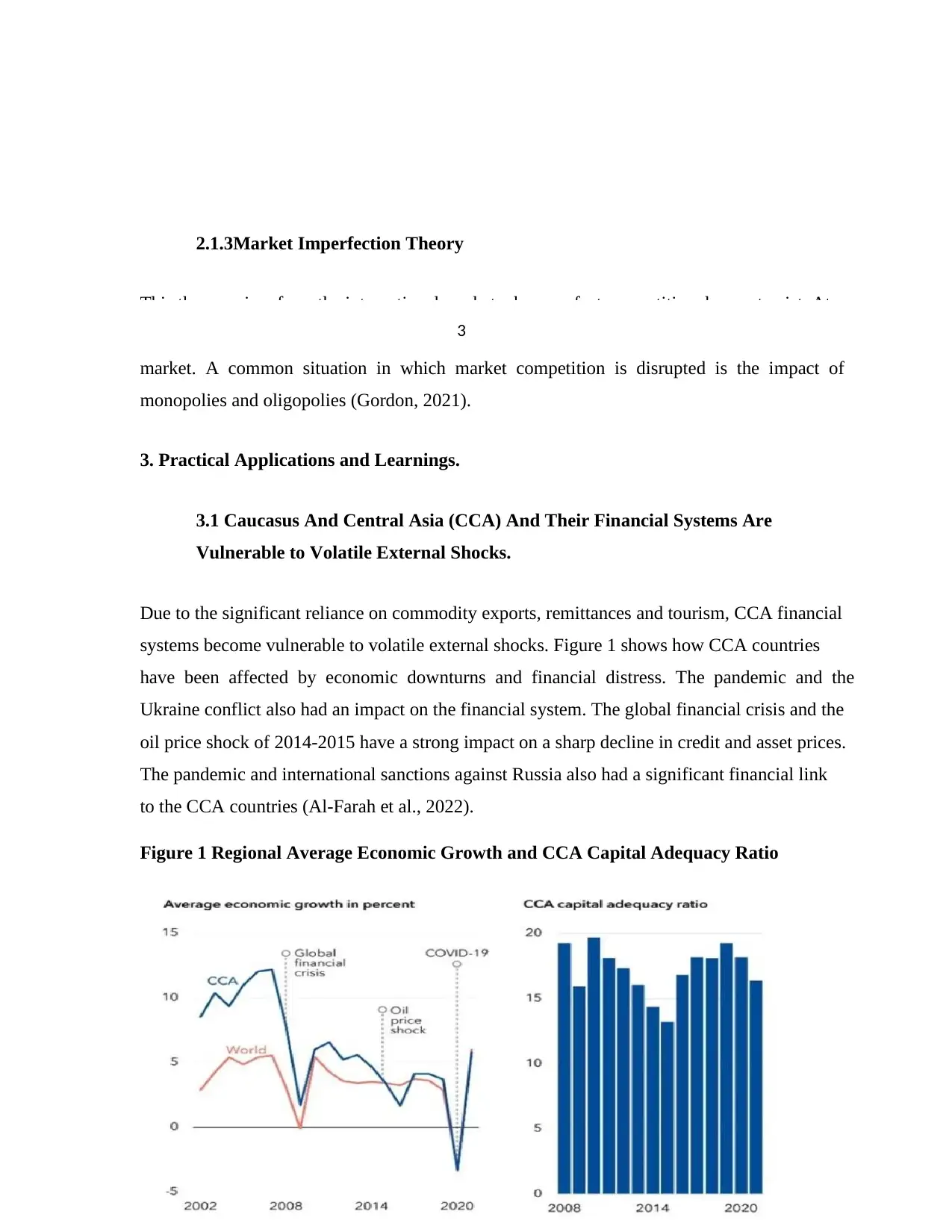
2.1.3Market Imperfection Theory
This theory arises from the international market where perfect competition does not exist. At
least one of the assumptions of perfect competition is violated, resulting in an imperfect
market. A common situation in which market competition is disrupted is the impact of
monopolies and oligopolies (Gordon, 2021).
3. Practical Applications and Learnings.
3.1 Caucasus And Central Asia (CCA) And Their Financial Systems Are
Vulnerable to Volatile External Shocks.
Due to the significant reliance on commodity exports, remittances and tourism, CCA financial
systems become vulnerable to volatile external shocks. Figure 1 shows how CCA countries
have been affected by economic downturns and financial distress. The pandemic and the
Ukraine conflict also had an impact on the financial system. The global financial crisis and the
oil price shock of 2014-2015 have a strong impact on a sharp decline in credit and asset prices.
The pandemic and international sanctions against Russia also had a significant financial link
to the CCA countries (Al-Farah et al., 2022).
Figure 1 Regional Average Economic Growth and CCA Capital Adequacy Ratio
3
This theory arises from the international market where perfect competition does not exist. At
least one of the assumptions of perfect competition is violated, resulting in an imperfect
market. A common situation in which market competition is disrupted is the impact of
monopolies and oligopolies (Gordon, 2021).
3. Practical Applications and Learnings.
3.1 Caucasus And Central Asia (CCA) And Their Financial Systems Are
Vulnerable to Volatile External Shocks.
Due to the significant reliance on commodity exports, remittances and tourism, CCA financial
systems become vulnerable to volatile external shocks. Figure 1 shows how CCA countries
have been affected by economic downturns and financial distress. The pandemic and the
Ukraine conflict also had an impact on the financial system. The global financial crisis and the
oil price shock of 2014-2015 have a strong impact on a sharp decline in credit and asset prices.
The pandemic and international sanctions against Russia also had a significant financial link
to the CCA countries (Al-Farah et al., 2022).
Figure 1 Regional Average Economic Growth and CCA Capital Adequacy Ratio
3
Paraphrase This Document
Need a fresh take? Get an instant paraphrase of this document with our AI Paraphraser
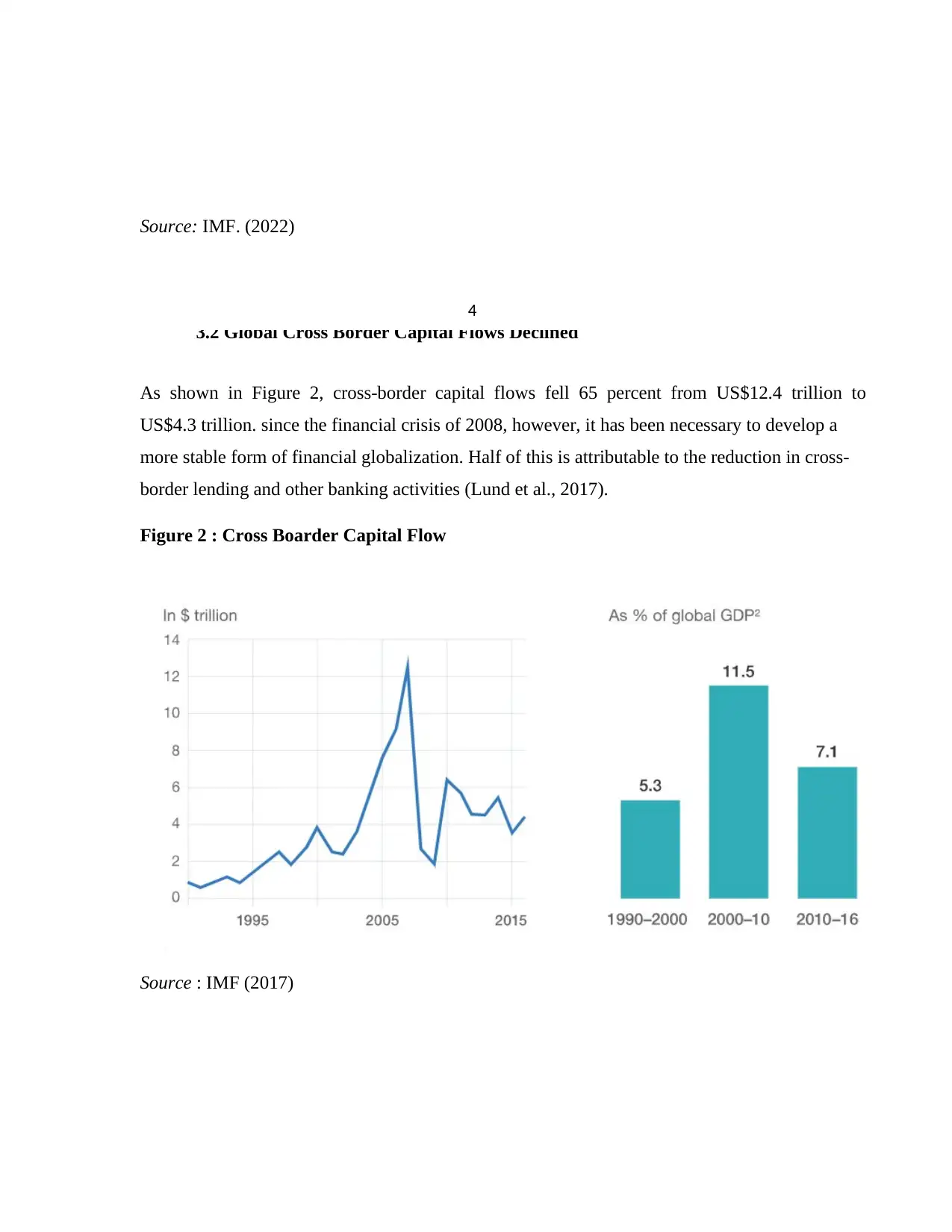
Source: IMF. (2022)
3.2 Global Cross Border Capital Flows Declined
As shown in Figure 2, cross-border capital flows fell 65 percent from US$12.4 trillion to
US$4.3 trillion. since the financial crisis of 2008, however, it has been necessary to develop a
more stable form of financial globalization. Half of this is attributable to the reduction in cross-
border lending and other banking activities (Lund et al., 2017).
Figure 2 : Cross Boarder Capital Flow
Source : IMF (2017)
4
3.2 Global Cross Border Capital Flows Declined
As shown in Figure 2, cross-border capital flows fell 65 percent from US$12.4 trillion to
US$4.3 trillion. since the financial crisis of 2008, however, it has been necessary to develop a
more stable form of financial globalization. Half of this is attributable to the reduction in cross-
border lending and other banking activities (Lund et al., 2017).
Figure 2 : Cross Boarder Capital Flow
Source : IMF (2017)
4
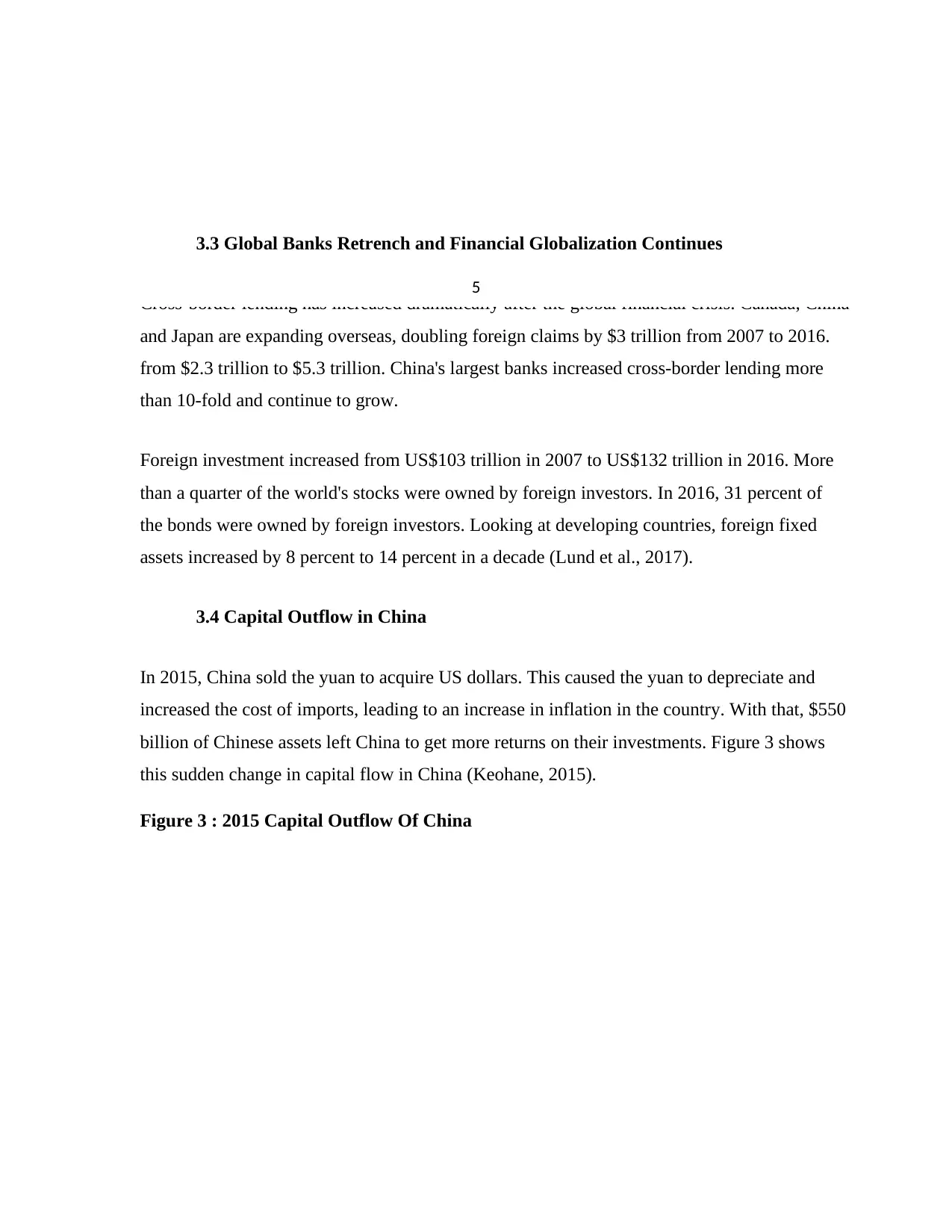
3.3 Global Banks Retrench and Financial Globalization Continues
Cross-border lending has increased dramatically after the global financial crisis. Canada, China
and Japan are expanding overseas, doubling foreign claims by $3 trillion from 2007 to 2016.
from $2.3 trillion to $5.3 trillion. China's largest banks increased cross-border lending more
than 10-fold and continue to grow.
Foreign investment increased from US$103 trillion in 2007 to US$132 trillion in 2016. More
than a quarter of the world's stocks were owned by foreign investors. In 2016, 31 percent of
the bonds were owned by foreign investors. Looking at developing countries, foreign fixed
assets increased by 8 percent to 14 percent in a decade (Lund et al., 2017).
3.4 Capital Outflow in China
In 2015, China sold the yuan to acquire US dollars. This caused the yuan to depreciate and
increased the cost of imports, leading to an increase in inflation in the country. With that, $550
billion of Chinese assets left China to get more returns on their investments. Figure 3 shows
this sudden change in capital flow in China (Keohane, 2015).
Figure 3 : 2015 Capital Outflow Of China
5
Cross-border lending has increased dramatically after the global financial crisis. Canada, China
and Japan are expanding overseas, doubling foreign claims by $3 trillion from 2007 to 2016.
from $2.3 trillion to $5.3 trillion. China's largest banks increased cross-border lending more
than 10-fold and continue to grow.
Foreign investment increased from US$103 trillion in 2007 to US$132 trillion in 2016. More
than a quarter of the world's stocks were owned by foreign investors. In 2016, 31 percent of
the bonds were owned by foreign investors. Looking at developing countries, foreign fixed
assets increased by 8 percent to 14 percent in a decade (Lund et al., 2017).
3.4 Capital Outflow in China
In 2015, China sold the yuan to acquire US dollars. This caused the yuan to depreciate and
increased the cost of imports, leading to an increase in inflation in the country. With that, $550
billion of Chinese assets left China to get more returns on their investments. Figure 3 shows
this sudden change in capital flow in China (Keohane, 2015).
Figure 3 : 2015 Capital Outflow Of China
5
⊘ This is a preview!⊘
Do you want full access?
Subscribe today to unlock all pages.

Trusted by 1+ million students worldwide
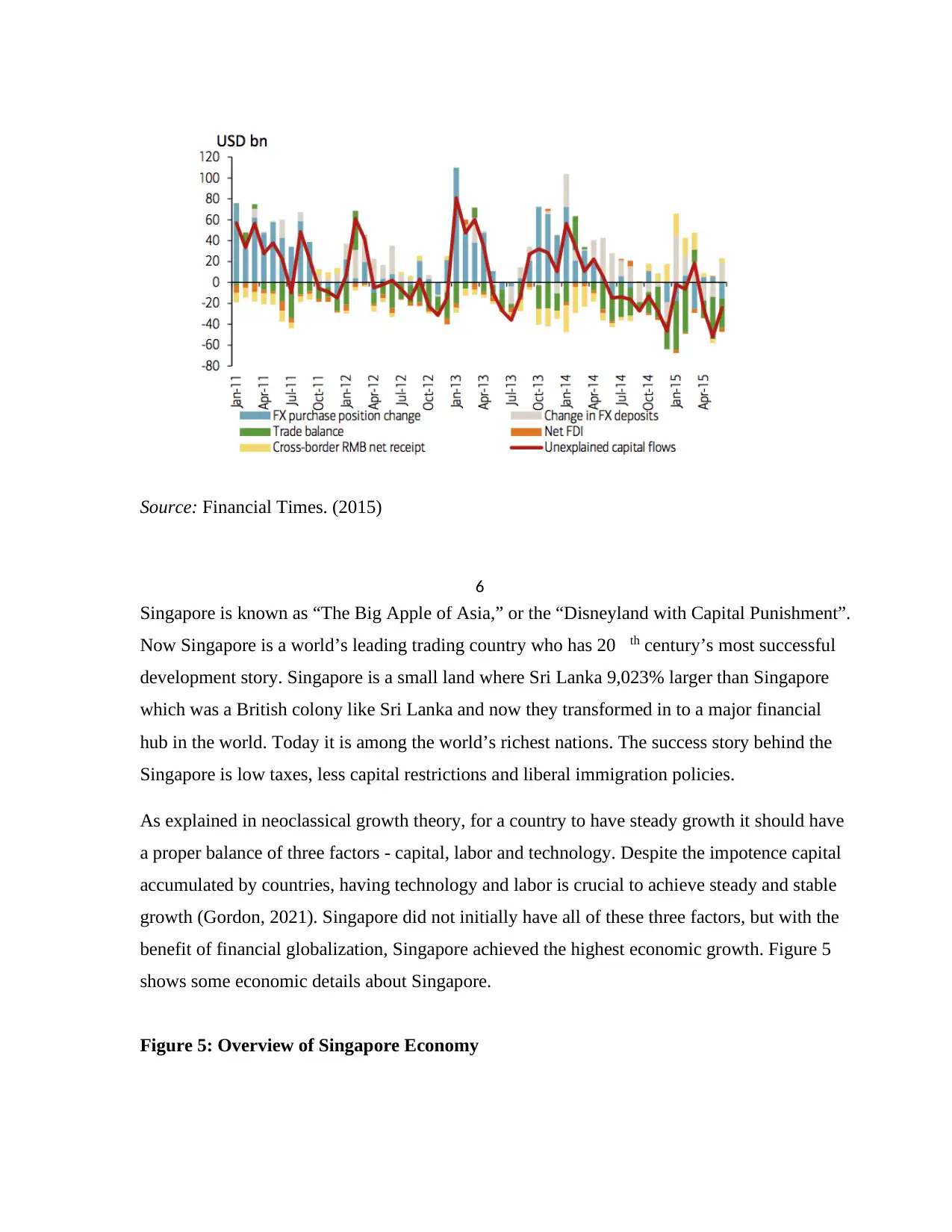
Source: Financial Times. (2015)
4. The Power of Financial Globalization: Singapore’s Economic Rise
Singapore is known as “The Big Apple of Asia,” or the “Disneyland with Capital Punishment”.
Now Singapore is a world’s leading trading country who has 20 th century’s most successful
development story. Singapore is a small land where Sri Lanka 9,023% larger than Singapore
which was a British colony like Sri Lanka and now they transformed in to a major financial
hub in the world. Today it is among the world’s richest nations. The success story behind the
Singapore is low taxes, less capital restrictions and liberal immigration policies.
As explained in neoclassical growth theory, for a country to have steady growth it should have
a proper balance of three factors - capital, labor and technology. Despite the impotence capital
accumulated by countries, having technology and labor is crucial to achieve steady and stable
growth (Gordon, 2021). Singapore did not initially have all of these three factors, but with the
benefit of financial globalization, Singapore achieved the highest economic growth. Figure 5
shows some economic details about Singapore.
Figure 5: Overview of Singapore Economy
6
4. The Power of Financial Globalization: Singapore’s Economic Rise
Singapore is known as “The Big Apple of Asia,” or the “Disneyland with Capital Punishment”.
Now Singapore is a world’s leading trading country who has 20 th century’s most successful
development story. Singapore is a small land where Sri Lanka 9,023% larger than Singapore
which was a British colony like Sri Lanka and now they transformed in to a major financial
hub in the world. Today it is among the world’s richest nations. The success story behind the
Singapore is low taxes, less capital restrictions and liberal immigration policies.
As explained in neoclassical growth theory, for a country to have steady growth it should have
a proper balance of three factors - capital, labor and technology. Despite the impotence capital
accumulated by countries, having technology and labor is crucial to achieve steady and stable
growth (Gordon, 2021). Singapore did not initially have all of these three factors, but with the
benefit of financial globalization, Singapore achieved the highest economic growth. Figure 5
shows some economic details about Singapore.
Figure 5: Overview of Singapore Economy
6
Paraphrase This Document
Need a fresh take? Get an instant paraphrase of this document with our AI Paraphraser
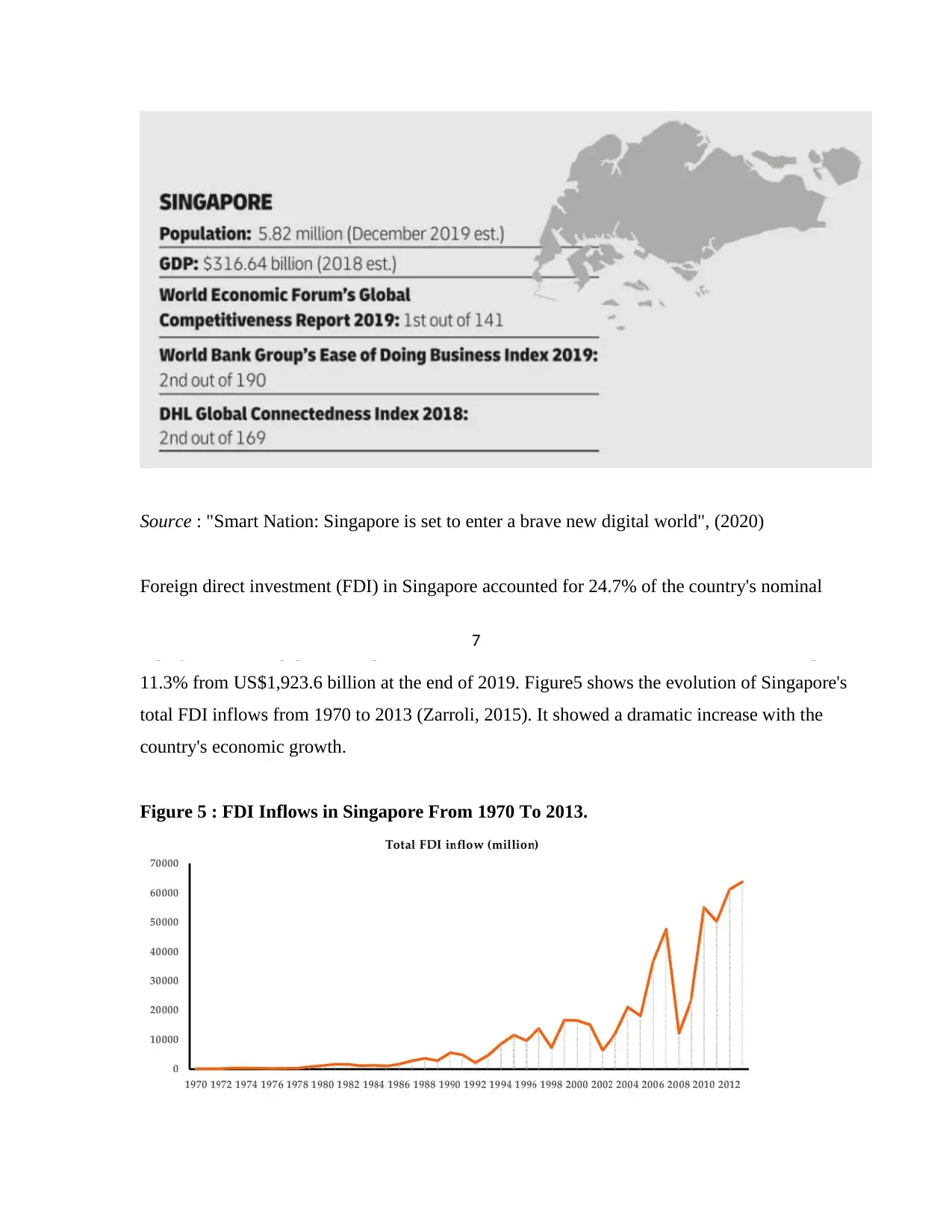
Source : "Smart Nation: Singapore is set to enter a brave new digital world", (2020)
Foreign direct investment (FDI) in Singapore accounted for 24.7% of the country's nominal
GDP as of December 2020. And the compared growth was 23.2% in the previous quarter.
Equity FDI in Singapore's corporate sector was US$2,141.8 billion at the end of 2020, up
11.3% from US$1,923.6 billion at the end of 2019. Figure5 shows the evolution of Singapore's
total FDI inflows from 1970 to 2013 (Zarroli, 2015). It showed a dramatic increase with the
country's economic growth.
Figure 5 : FDI Inflows in Singapore From 1970 To 2013.
7
Foreign direct investment (FDI) in Singapore accounted for 24.7% of the country's nominal
GDP as of December 2020. And the compared growth was 23.2% in the previous quarter.
Equity FDI in Singapore's corporate sector was US$2,141.8 billion at the end of 2020, up
11.3% from US$1,923.6 billion at the end of 2019. Figure5 shows the evolution of Singapore's
total FDI inflows from 1970 to 2013 (Zarroli, 2015). It showed a dramatic increase with the
country's economic growth.
Figure 5 : FDI Inflows in Singapore From 1970 To 2013.
7
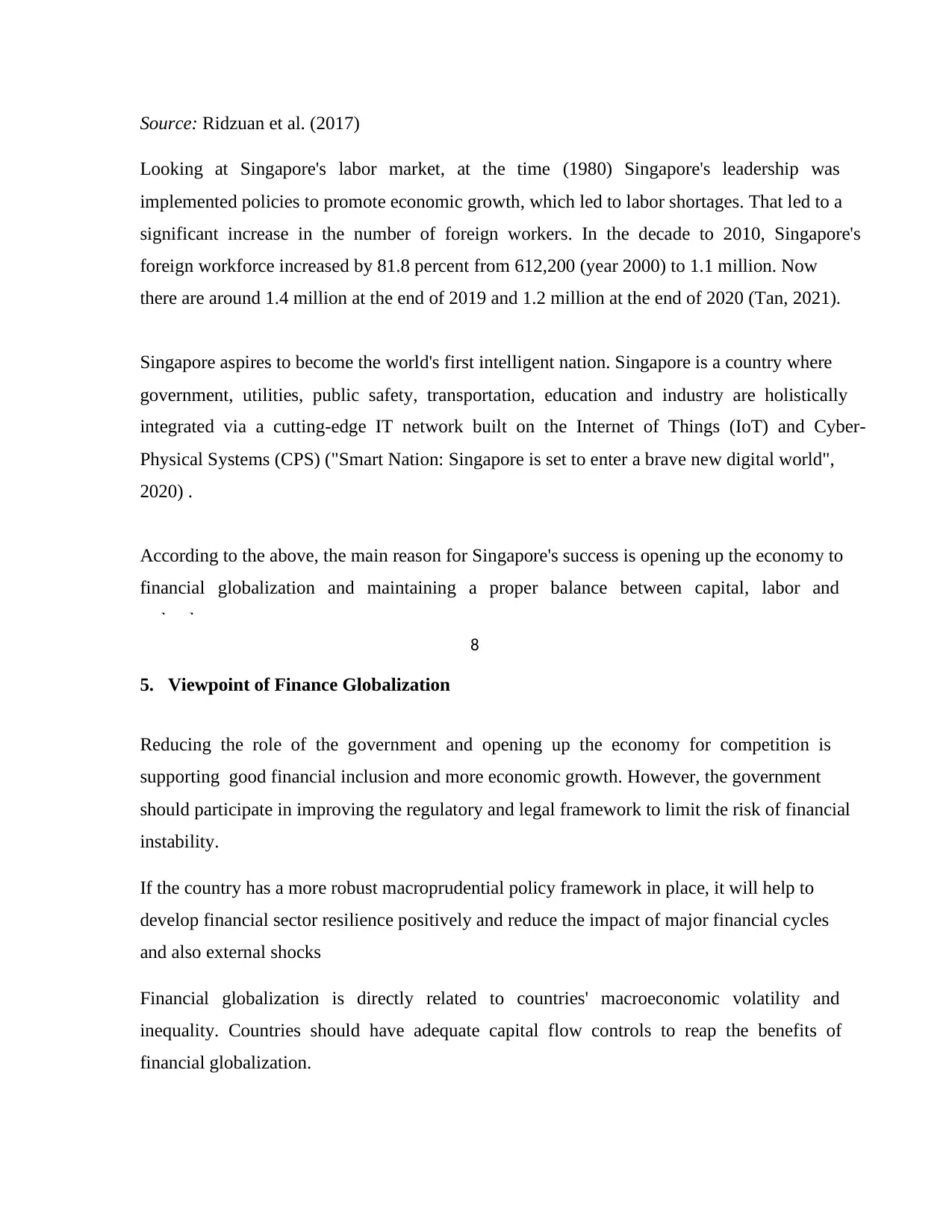
Source: Ridzuan et al. (2017)
Looking at Singapore's labor market, at the time (1980) Singapore's leadership was
implemented policies to promote economic growth, which led to labor shortages. That led to a
significant increase in the number of foreign workers. In the decade to 2010, Singapore's
foreign workforce increased by 81.8 percent from 612,200 (year 2000) to 1.1 million. Now
there are around 1.4 million at the end of 2019 and 1.2 million at the end of 2020 (Tan, 2021).
Singapore aspires to become the world's first intelligent nation. Singapore is a country where
government, utilities, public safety, transportation, education and industry are holistically
integrated via a cutting-edge IT network built on the Internet of Things (IoT) and Cyber-
Physical Systems (CPS) ("Smart Nation: Singapore is set to enter a brave new digital world",
2020) .
According to the above, the main reason for Singapore's success is opening up the economy to
financial globalization and maintaining a proper balance between capital, labor and
technology.
5. Viewpoint of Finance Globalization
Reducing the role of the government and opening up the economy for competition is
supporting good financial inclusion and more economic growth. However, the government
should participate in improving the regulatory and legal framework to limit the risk of financial
instability.
If the country has a more robust macroprudential policy framework in place, it will help to
develop financial sector resilience positively and reduce the impact of major financial cycles
and also external shocks
Financial globalization is directly related to countries' macroeconomic volatility and
inequality. Countries should have adequate capital flow controls to reap the benefits of
financial globalization.
8
Looking at Singapore's labor market, at the time (1980) Singapore's leadership was
implemented policies to promote economic growth, which led to labor shortages. That led to a
significant increase in the number of foreign workers. In the decade to 2010, Singapore's
foreign workforce increased by 81.8 percent from 612,200 (year 2000) to 1.1 million. Now
there are around 1.4 million at the end of 2019 and 1.2 million at the end of 2020 (Tan, 2021).
Singapore aspires to become the world's first intelligent nation. Singapore is a country where
government, utilities, public safety, transportation, education and industry are holistically
integrated via a cutting-edge IT network built on the Internet of Things (IoT) and Cyber-
Physical Systems (CPS) ("Smart Nation: Singapore is set to enter a brave new digital world",
2020) .
According to the above, the main reason for Singapore's success is opening up the economy to
financial globalization and maintaining a proper balance between capital, labor and
technology.
5. Viewpoint of Finance Globalization
Reducing the role of the government and opening up the economy for competition is
supporting good financial inclusion and more economic growth. However, the government
should participate in improving the regulatory and legal framework to limit the risk of financial
instability.
If the country has a more robust macroprudential policy framework in place, it will help to
develop financial sector resilience positively and reduce the impact of major financial cycles
and also external shocks
Financial globalization is directly related to countries' macroeconomic volatility and
inequality. Countries should have adequate capital flow controls to reap the benefits of
financial globalization.
8
⊘ This is a preview!⊘
Do you want full access?
Subscribe today to unlock all pages.

Trusted by 1+ million students worldwide
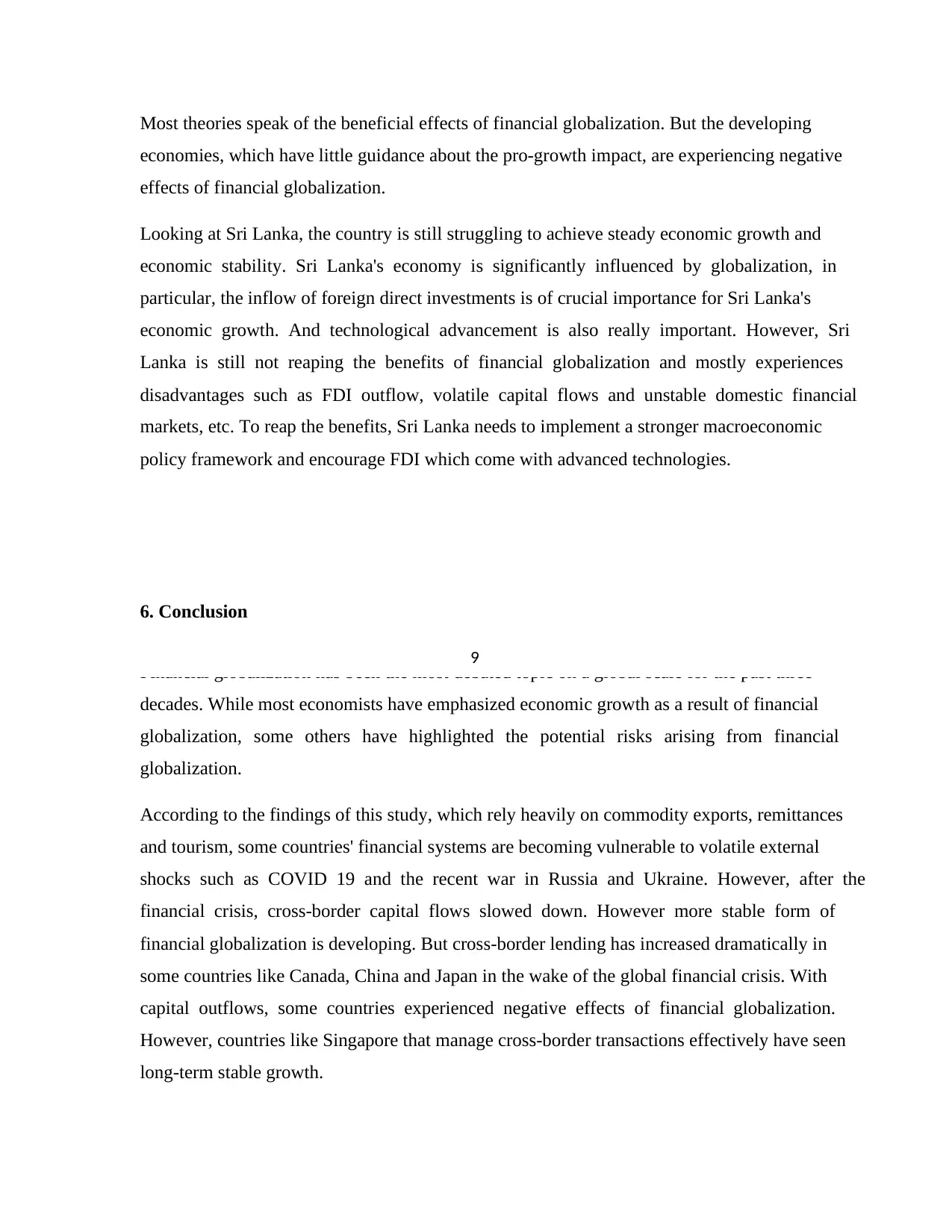
Most theories speak of the beneficial effects of financial globalization. But the developing
economies, which have little guidance about the pro-growth impact, are experiencing negative
effects of financial globalization.
Looking at Sri Lanka, the country is still struggling to achieve steady economic growth and
economic stability. Sri Lanka's economy is significantly influenced by globalization, in
particular, the inflow of foreign direct investments is of crucial importance for Sri Lanka's
economic growth. And technological advancement is also really important. However, Sri
Lanka is still not reaping the benefits of financial globalization and mostly experiences
disadvantages such as FDI outflow, volatile capital flows and unstable domestic financial
markets, etc. To reap the benefits, Sri Lanka needs to implement a stronger macroeconomic
policy framework and encourage FDI which come with advanced technologies.
6. Conclusion
Financial globalization has been the most debated topic on a global scale for the past three
decades. While most economists have emphasized economic growth as a result of financial
globalization, some others have highlighted the potential risks arising from financial
globalization.
According to the findings of this study, which rely heavily on commodity exports, remittances
and tourism, some countries' financial systems are becoming vulnerable to volatile external
shocks such as COVID 19 and the recent war in Russia and Ukraine. However, after the
financial crisis, cross-border capital flows slowed down. However more stable form of
financial globalization is developing. But cross-border lending has increased dramatically in
some countries like Canada, China and Japan in the wake of the global financial crisis. With
capital outflows, some countries experienced negative effects of financial globalization.
However, countries like Singapore that manage cross-border transactions effectively have seen
long-term stable growth.
9
economies, which have little guidance about the pro-growth impact, are experiencing negative
effects of financial globalization.
Looking at Sri Lanka, the country is still struggling to achieve steady economic growth and
economic stability. Sri Lanka's economy is significantly influenced by globalization, in
particular, the inflow of foreign direct investments is of crucial importance for Sri Lanka's
economic growth. And technological advancement is also really important. However, Sri
Lanka is still not reaping the benefits of financial globalization and mostly experiences
disadvantages such as FDI outflow, volatile capital flows and unstable domestic financial
markets, etc. To reap the benefits, Sri Lanka needs to implement a stronger macroeconomic
policy framework and encourage FDI which come with advanced technologies.
6. Conclusion
Financial globalization has been the most debated topic on a global scale for the past three
decades. While most economists have emphasized economic growth as a result of financial
globalization, some others have highlighted the potential risks arising from financial
globalization.
According to the findings of this study, which rely heavily on commodity exports, remittances
and tourism, some countries' financial systems are becoming vulnerable to volatile external
shocks such as COVID 19 and the recent war in Russia and Ukraine. However, after the
financial crisis, cross-border capital flows slowed down. However more stable form of
financial globalization is developing. But cross-border lending has increased dramatically in
some countries like Canada, China and Japan in the wake of the global financial crisis. With
capital outflows, some countries experienced negative effects of financial globalization.
However, countries like Singapore that manage cross-border transactions effectively have seen
long-term stable growth.
9
Paraphrase This Document
Need a fresh take? Get an instant paraphrase of this document with our AI Paraphraser
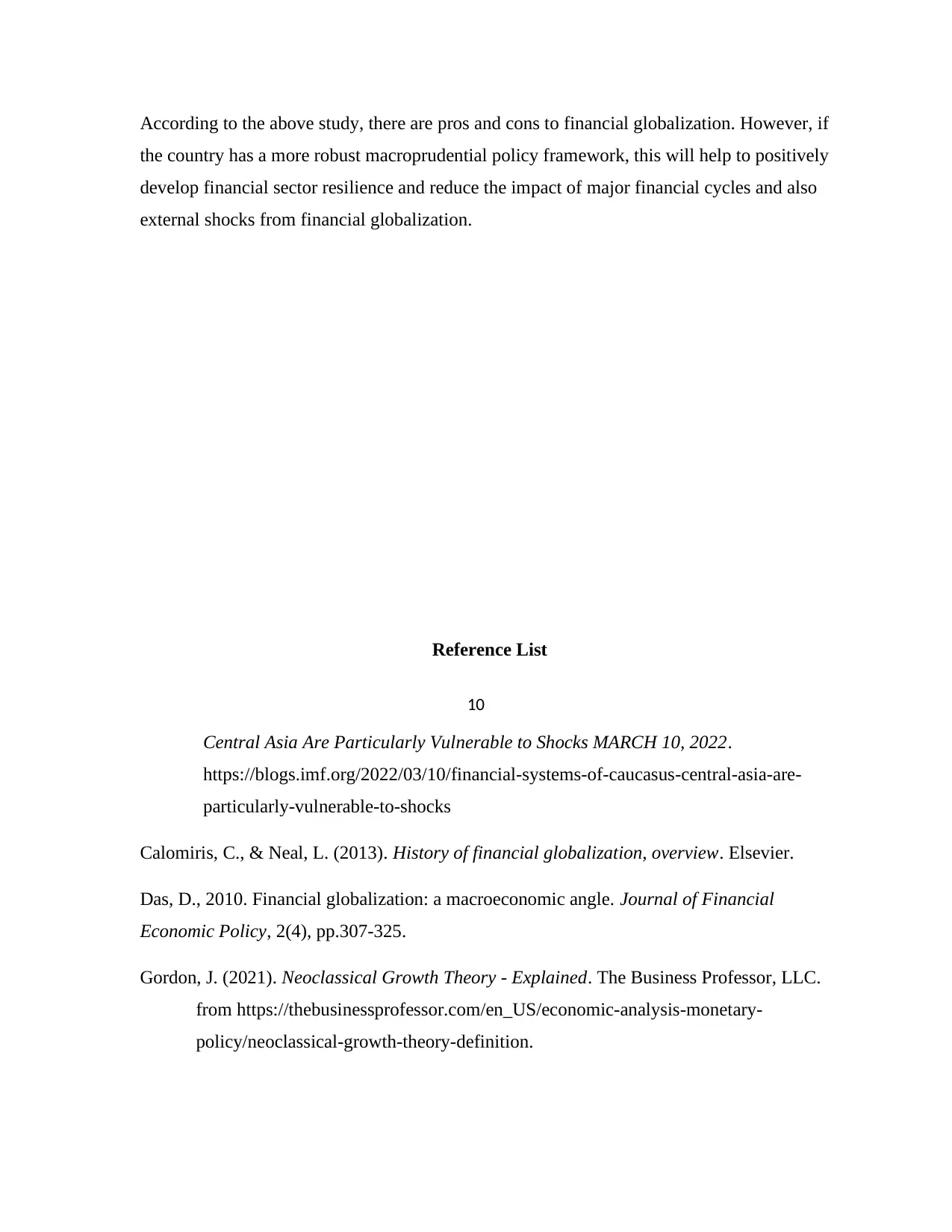
According to the above study, there are pros and cons to financial globalization. However, if
the country has a more robust macroprudential policy framework, this will help to positively
develop financial sector resilience and reduce the impact of major financial cycles and also
external shocks from financial globalization.
Reference List
Al-Farah, R., Akepanidtaworn, K., & Mirzayev, S. (2022). Financial Systems of Caucasus,
Central Asia Are Particularly Vulnerable to Shocks MARCH 10, 2022.
https://blogs.imf.org/2022/03/10/financial-systems-of-caucasus-central-asia-are-
particularly-vulnerable-to-shocks
Calomiris, C., & Neal, L. (2013). History of financial globalization, overview. Elsevier.
Das, D., 2010. Financial globalization: a macroeconomic angle. Journal of Financial
Economic Policy, 2(4), pp.307-325.
Gordon, J. (2021). Neoclassical Growth Theory - Explained. The Business Professor, LLC.
from https://thebusinessprofessor.com/en_US/economic-analysis-monetary-
policy/neoclassical-growth-theory-definition.
10
the country has a more robust macroprudential policy framework, this will help to positively
develop financial sector resilience and reduce the impact of major financial cycles and also
external shocks from financial globalization.
Reference List
Al-Farah, R., Akepanidtaworn, K., & Mirzayev, S. (2022). Financial Systems of Caucasus,
Central Asia Are Particularly Vulnerable to Shocks MARCH 10, 2022.
https://blogs.imf.org/2022/03/10/financial-systems-of-caucasus-central-asia-are-
particularly-vulnerable-to-shocks
Calomiris, C., & Neal, L. (2013). History of financial globalization, overview. Elsevier.
Das, D., 2010. Financial globalization: a macroeconomic angle. Journal of Financial
Economic Policy, 2(4), pp.307-325.
Gordon, J. (2021). Neoclassical Growth Theory - Explained. The Business Professor, LLC.
from https://thebusinessprofessor.com/en_US/economic-analysis-monetary-
policy/neoclassical-growth-theory-definition.
10
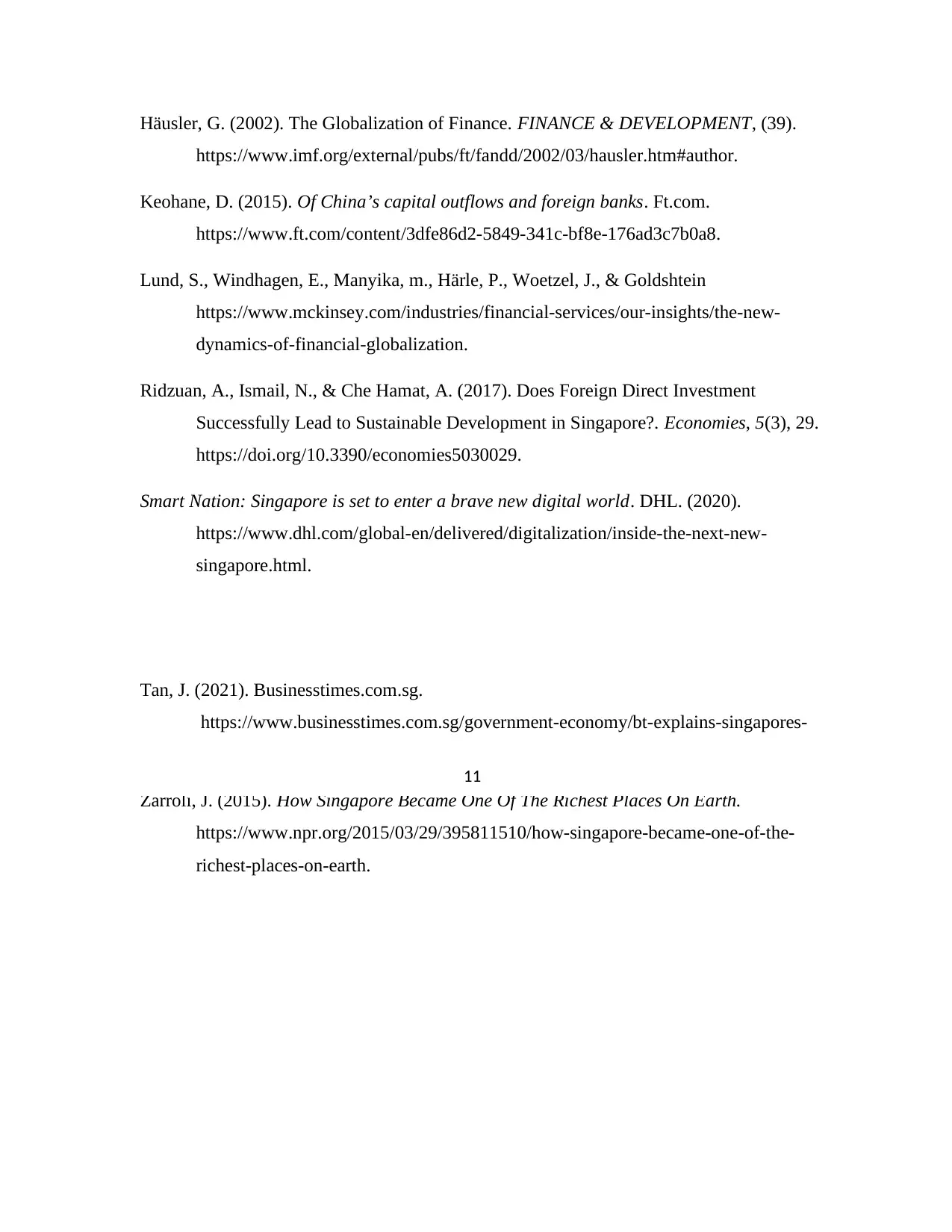
Häusler, G. (2002). The Globalization of Finance. FINANCE & DEVELOPMENT, (39).
https://www.imf.org/external/pubs/ft/fandd/2002/03/hausler.htm#author.
Keohane, D. (2015). Of China’s capital outflows and foreign banks. Ft.com.
https://www.ft.com/content/3dfe86d2-5849-341c-bf8e-176ad3c7b0a8.
Lund, S., Windhagen, E., Manyika, m., Härle, P., Woetzel, J., & Goldshtein
https://www.mckinsey.com/industries/financial-services/our-insights/the-new-
dynamics-of-financial-globalization.
Ridzuan, A., Ismail, N., & Che Hamat, A. (2017). Does Foreign Direct Investment
Successfully Lead to Sustainable Development in Singapore?. Economies, 5(3), 29.
https://doi.org/10.3390/economies5030029.
Smart Nation: Singapore is set to enter a brave new digital world. DHL. (2020).
https://www.dhl.com/global-en/delivered/digitalization/inside-the-next-new-
singapore.html.
Tan, J. (2021). Businesstimes.com.sg.
https://www.businesstimes.com.sg/government-economy/bt-explains-singapores-
love-hate-relationship-with-foreign-workers.
Zarroli, J. (2015). How Singapore Became One Of The Richest Places On Earth.
https://www.npr.org/2015/03/29/395811510/how-singapore-became-one-of-the-
richest-places-on-earth.
11
https://www.imf.org/external/pubs/ft/fandd/2002/03/hausler.htm#author.
Keohane, D. (2015). Of China’s capital outflows and foreign banks. Ft.com.
https://www.ft.com/content/3dfe86d2-5849-341c-bf8e-176ad3c7b0a8.
Lund, S., Windhagen, E., Manyika, m., Härle, P., Woetzel, J., & Goldshtein
https://www.mckinsey.com/industries/financial-services/our-insights/the-new-
dynamics-of-financial-globalization.
Ridzuan, A., Ismail, N., & Che Hamat, A. (2017). Does Foreign Direct Investment
Successfully Lead to Sustainable Development in Singapore?. Economies, 5(3), 29.
https://doi.org/10.3390/economies5030029.
Smart Nation: Singapore is set to enter a brave new digital world. DHL. (2020).
https://www.dhl.com/global-en/delivered/digitalization/inside-the-next-new-
singapore.html.
Tan, J. (2021). Businesstimes.com.sg.
https://www.businesstimes.com.sg/government-economy/bt-explains-singapores-
love-hate-relationship-with-foreign-workers.
Zarroli, J. (2015). How Singapore Became One Of The Richest Places On Earth.
https://www.npr.org/2015/03/29/395811510/how-singapore-became-one-of-the-
richest-places-on-earth.
11
⊘ This is a preview!⊘
Do you want full access?
Subscribe today to unlock all pages.

Trusted by 1+ million students worldwide
1 out of 12
Related Documents
Your All-in-One AI-Powered Toolkit for Academic Success.
+13062052269
info@desklib.com
Available 24*7 on WhatsApp / Email
![[object Object]](/_next/static/media/star-bottom.7253800d.svg)
Unlock your academic potential
Copyright © 2020–2025 A2Z Services. All Rights Reserved. Developed and managed by ZUCOL.




